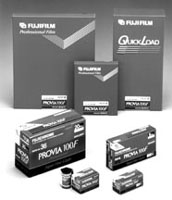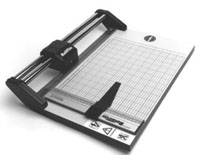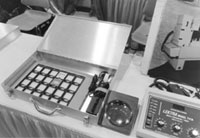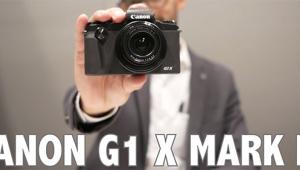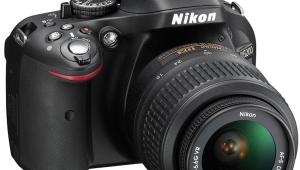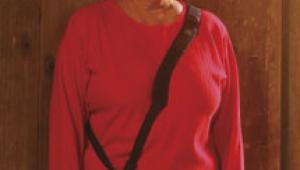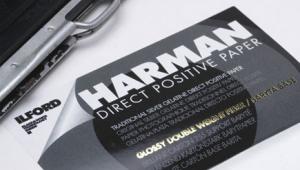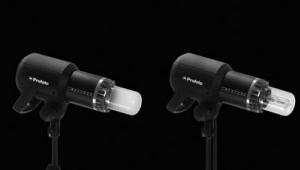PMA International
Darkroom Products
Probably the most important
message from PMA 1999 was that you have even more choice and versatility
than ever when it comes to producing images. There is more and more
integration of traditional silver halide technology with digital technology.
Even Luminos, well-known for their premium photographic papers, liquid
emulsion, toners, and alternative process kits, are now in the digital
market with ink jet papers and inks. Although these are covered in other
PMA reports, it is an important point that these products incorporate
advances in ink jet technology which will make your images more stable.
|
|||
Oriental, too, is making a
strong comeback, with new distribution by International Supplies in Los
Angeles. To emphasize that there has been no loss of quality, they showed
me two sample images. One was printed on Oriental paper six years ago,
and one was printed on the new generation paper. There was no difference.
Although there were no new items since last PMA, they are considering
bringing their panchromatic black and white paper into the US (it is already
available in Japan). Panchro-matic paper is designed for printing color
negatives as monochrome prints without the grainy, harsh contrast and
odd tones that you get when you use conventional black and white paper.
|
|||
Rumor had it at the show that
Kodak would be producing a new color paper called Ultra III in the next
month or so, so it may be available by the time you read this. There were
no samples at the show, but it is going to be a high contrast material,
available in rolls and sheets. It is not a replacement, but rather a new
paper to fill out the line. |
|||
Because 1998 was a photokina
year, most of the film introductions were announced at that show, and
PMA was the US debut for them. There were a few additions though. The
Kodak Select Series now includes a chromogenic monochrome film. This is
closely related to the professional T400CN, but not identical. One of
the most significant differences is that it is balanced so that minilabs
can use the "Gold channel" (for regular Kodak Gold color films)
rather than having to set up a special channel for chromo-genic film.
The Select film is also designed to have more latitude than T400CN (plus
three to minus two stops), and is optimized for printing on color materials.
For those hobbyists who want to print their own negatives on black and
white paper, T400CN is still the recommended film. |
|||
Kodak is continuing their policy
of making it easier for the customer to choose the right film, by simplifying
the names. Kodak Gold 400 has now been renamed Kodak Max 400. This film
still uses the Kodak Gold technology which is particularly good for people
pictures. |
|||
In instant films, Polaroid's
new tiny format should be on the market sometime this summer. They decided
on the Japanese name "Joycam." The actual image is a print
the size of a 35mm slide. A new variation on the Polaroid 600 is a greeting
card variety pack which contains five standup greeting cards, five envelopes,
and 10 exposures of Polaroid 600 instant film. Each card has a base which
unfolds to allow the picture to stand up on its own. |
|||
Imation announced their entry
into the 24mm Advanced Photo System with an ISO 200 color print film.
It is a medium speed, daylight-balanced film, which can cope well with
mixed lighting and flash. The edge markings are optical and magnetic. |
|||
Although quite a few companies
who produce photographic chemicals attend PMA, they mostly produce commercial
chemicals for minilabs. New introductions for end users tend to be few
and far between. |
|||
Falcon Safety Products, who
make Edwal chemicals, announced that their Antistat Film Cleaner has been
reformulated to meet EPA standards. A new ink jet fix is available from
HP Marketing. This protects against moisture and fading. |
|||
If you are interested in handcoloring,
but don't have a darkroom to make your own prints, or if you aren't
sure how to print for handcoloring, you can get sets of prints to color.
These are printed on semimatte paper and come with instructions as well
as "before" and "after" pictures. A new catalog
features all of Marshall's products, along with hints and tips.
|
|||
There weren't many introductions
in darkroom equipment, but one of the most notable was a brand new version
of the classic De Vere 203, manufactured in En-gland. One of the most
convenient features of this enlarger is that the controls for head elevation
and focusing are on the front of the baseboard. The enlarger chassis can
be fitted with a choice of four light sources: cold cathode, condenser
(Varicon), and Ilford Multigrade, plus the Dichromat color head. The monochrome
lamps will all handle 6x9cm, though the color head covers only 6x7cm (and
of course smaller formats). Information on all De Vere products, including
spares for old enlargers, is available from TruTrack. |
|||
Tiffen/Saunders, who carry
Wein flash slaves and remote control systems, showed me another of Wein's
inventions: the Air Supply, a personal air purifier which you can wear
around your neck. The idea is that the unit cleans the air in your breathing
space and eliminates airborne pollutants, allergens, and even viruses.
Tif-fen has not yet decided whether to distri- bute this item, but they
can give you information. I have ask-ed for one for evaluation, as this
sounds like a brilliant idea to me. |
|||
Tiffen showed a new digital
timer from LPL called the ET-500. It is micro-processor controlled and
can be used as an enlarger timer or a process timer. Timing can be measures
in seconds (from 0 to 999) or tenths of a second (0 to 99.9). The variable
brightness LED display can be turned off if you are working with color.
You can choose between a "Count-buzzer mode" which beeps every
second, or an "End-buzzer" mode which indicates the completion
of the process. There is a plug-in outlet for a safelight, so that the
safelight is on when the enlarger light is off, but it turns off when
the Start button is pressed. The ET-500 can be wall mounted and an optional
foot control switch is available. |
|||
The combined Jobo/Durst stand
was a veritable toy store for any-one interested in the darkroom. The
newest items (which previewed at photokina) were three handheld, battery-operated
printing accessories--the Protime, the Comparator 100, and the Colorline
100. The Durst Filmetta and the new Variolux enlarging exposure meter
were also drawing a lot of interest. |
|||
LPL had their own booth, showing
a small copy stand for digital and conventional copying with a small camera.
The arm on the copy stand has an adjusting screw which allows you to cantilever
the camera out over the baseboard. The top of the copy arm is fitted with
a ball-and-socket at the top. The max- imum load it can support is 500g
(rather over 1 lb). The baseboard is 250x350mm (about 10x14") and
weighs less than a pound. They also showed a copy stand column which can
be clamped to a table or desk. This is a conventional geared copy arm
which can support about 3 lbs. A double clamping system holds it firmly,
and the clamps can be reversed so that the floor can be used as a copy
platform. Option-al baseboards of 300x600mm (about 12x14") and 450x600mm
(about 18x24") are available. |
|||
Climax, who distribute various
darkroom items including Texa-Sinks, had some small, high (and low) intensity
gooseneck lights called Littlites. For anyone who needs high intensity
light for close work these look ideal. They can be fitted with a "Snap
Mount" which is self-adhesive hook and loop pads, or with a weighted
base, or an adjustable clamp. You can get all sorts of variations, with
or without dimmer, and even with a cigarette lighter adapter so you can
use them in a vehicle. They are available in several different lengths:
6, 12, and 18". The slotted hood of the high intensity version can
even take filters: dark or light red, amber, or blue. The light source
is quartz-halogen, either 12 volt 380m A, 5w for high intensity or 12v
230m A, 2.4w for low intensity. For further information or questions visit: www.rogerandfrances.com |
